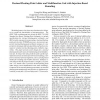52 search results - page 2 / 11 » The New IEEE-754 Standard for Floating Point Arithmetic |
ASAP
2004
IEEE
13 years 9 months ago
2004
IEEE
Decreasing feature sizes allow additional functionality to be added to future microprocessors to improve the performance of important application domains. As a result of rapid gro...
ASAP
2005
IEEE
13 years 11 months ago
2005
IEEE
With continued reductions in feature size, additional functionality may be added to future microprocessors to boost the performance of important application domains. Due to growth...
ARITH
2007
IEEE
13 years 11 months ago
2007
IEEE
Shrinking feature sizes gives more headroom for designers to extend the functionality of microprocessors. The IEEE 754R working group has revised the IEEE 754-1985 Standard for Bi...
ARITH
2003
IEEE
13 years 10 months ago
2003
IEEE
This work uses a partially redundant number system as an internal format for floating point arithmetic operations. The redundant number system enables carry free arithmetic opera...
ARITH
2001
IEEE
13 years 9 months ago
2001
IEEE
We give the results of our search for the worst cases for correct rounding of the major elementary functions in double precision floating-point arithmetic. These results allow the...

